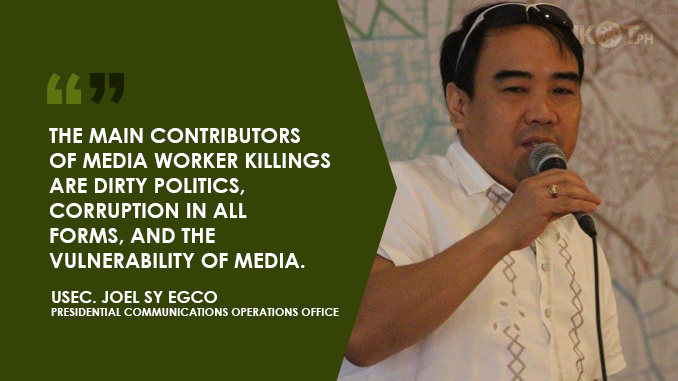The head of the Presidential Task Force on Media Security (PTFoMS) reported to the Senate its accomplishments, which he said were achieved despite formidable challenges, such as the lack of resources.
In his report to the Senate Committee on Public Information and Mass Media, Undersecretary Joel Sy Egco, executive director of PTFoMS, said the task force has acted on all cases of threats and violence against media workers group, including 17 monitored and acted upon incidents of killings — four of which were work-related and 13 were not related to work (personal grudges, politics and other reasons beyond media work).
The task force also investigated and solved 30 cases of reported threats, he added.
Senator Grace Poe commended the PTFoMS for its impressive performance as she vowed to give the task force more teeth by giving it more budget.
“Actually, you know Usec. Sy Egco, I would like to commend you. This is a very comprehensive report and I can see your sympathy towards your fellow journalists,” said Poe, chair of the Senate Committee on Public Information and Mass Media.
The legislator also said she is reviewing proposals to make the PTFoMS an independent Commission on Media Security.
The PTFoMS was created through Administrative Order (AO) No. 1 that was signed by President Rodrigo Duterte on Oct. 11, 2016.
As defined by AO No. 1, media workers are those who are legitimately engaged in media practice directly or indirectly, whether as a principal occupation or not, including but not limited to reporters, anchorpersons, commentators, columnists, cameramen, and photographers in print, radio, the internet or television.
Sy Egco, who is also a journalist, said media workers face three types of risks — duty, advocacy and crusade.
He said duty, which refers to the performance of the main functions of the journalist, is already risky in itself.
However, advocacy, which is the relentless criticisms made by journalists or reporters on a subject, doubles the risks.
Media workers are at most risk when they go on a crusade, Sy Egco noted.
“When somebody goes to crusade, the crossover from being a journalist to a politician, businessman and other careers is no longer words against words but swords against swords. It is no longer the reporting but the actual filing of cases that puts journalists at high risk,” he said.
The PTFoMS official said based on their assessments, media worker killings (MWK), per se, is a byproduct of a hostile and violent geo-political environment.
“The main contributors of MWK are dirty politics, corruption in all forms, and the vulnerability of media,” Sy Egco said.
Based on the observations made by the task force, media workers face risks from rivalries and infighting among various media groups and practitioners; economic vulnerability; correlation of media ownership and politics; block-timers are prone to violence; small entities are usually financed by politicians; media violence peaks around election season.
With midterm elections fast approaching, Sy Egco cited the need for immediate action “to prevent more killings.”
Sy Egco said in the 17 incidents of work-related cases that the PTFoMS has monitored and acted on, four were verified media killings.
Among those who were attacked but survived was Virgilio Maganes, a newspaper columnist and radio commentator, who was shot in Dagupan City, Pangasinan on Nov. 8, 2016. Through the actions of PTFoMs, in coordination with law enforcement agencies, a suspect was identified and has been charged with frustrated murder.
Another was Julito Orillaneda, a radio commentator of a community radio station in Marihatag town in Surigao del Sur, who was shot sometime in late July 2017. A certain Leonardo Zamora, a village councilor, was charged with frustrated murder.
Meanwhile, the first confirmed media killing under the watch of the PTFoMS was Larry Que, who was shot on Dec. 19, 2017 and died the following day. Charged were a Catanduanes governor, two policemen, and a staff of the governor. “The case is awaiting resolution from the Department of Justice,” Sy Egco said.
Also killed was radio anchor Christopher Lozada who was shot dead by unidentified gunmen in Barangay Coleta, Bislig City on Oct. 24, 2017.
“I went there personally. I personally investigated and conducted a case conference with police investigators.” Sy Egco told the Senate panel.
He said the suspect has been identified and currently has six standing warrants of arrests against him.
“He was identified by our star witness, who is under our protective custody somewhere here in Metro Manila,” Sy Egco added.
There was also Dennis Denora who was killed in Panabo City, Davao del Norte on June 7, 2018, and Joey Llana who was shot in Peñafrancia, Daraga on July 20, 2018.
“The shooting occurred while we were holding a seminar on AO 1 in Baguio. I went to Daraga the following day and formed a special investigation task group,” Sy Egco said.
A total of 30 non-work related cases were immediately acted on by the PTFoMS. These cases involved victims who were killed because of politics, personal grudges, or because of their other lines of work, with one case of a journalist being killed in a robbery-homicide case.
Sy Egco provided the Senate with the list of the 30 victims in the non-work related cases, as well as the numerous reports and complaints of harassment that the PTFoMS has received.
Sy Egco, who was also a former president of the National Press Club said he makes it a point to attend the wakes of all the victims of media killings, whether work-related or not.
“I believe that (by) interviewing the families and the friends of the victims, I’ll get enough information for sharing with the police,” he said. “Being a journalist myself, we have broken the wall of mistrust between families and investigators. The families tend to open up when they learn that I am also a media worker.”
“Being a journalist myself, we have broken the wall of mistrust between families and investigators. The families tend to open up when they learn that I am also a media worker.”
Meanwhile, Sy Egco said the PTFoMS is not only reactive, but has also undertaken proactive measures in the fulfillment of its mandate.
Among the proactive measures it has undertaken are red-flagging, where the suspects are warned for their actions against media workers; the quick reaction system; creation of the PTFoMS protocols, a handbook on personal security measures; and regional seminars and regular meetings to appraise the task force of the cases at hand.
“We are looking at printing an initial 10,000 copies of the protocols for distribution to media workers,” Sy Egco said.
All these, he said, were accomplished despite formidable challenges.
The PTFoMS first started with only a core group that was complemented with mostly volunteers.
Sy Egco said they were provided with a small room that can only accommodate four persons and sometimes have to discuss strategies under the trees near the New Executive Building in Malacañang.
While the task force is now complemented with a mostly regular staff, and is housed in an office that is ample for their needs, the new accommodation has no internet connection.
“We are also coping with low wages for our staff and we have no operational budget on our own,” Sy Egco said.
All praises
At the end of his report, Poe was all praises for Sy Egco and the PTFoMS.
“I really appreciate it because I have been conducting several hearings on media killings and this is probably the most detailed report on what’s been happening in certain cases,” Poe said.
The senator also proposed the inclusion of a specific budget for the PTFoMS in the national budget after learning that the task force has no specific budget.
“May request lang po kami. Wala po kaming specific budget. But the Office of the President asked us to submit our programs for the year and I think they allotted us a little over P10 million,” Sy Egco said when prompted by Poe.
“Your honor, the lack of resources has made us resourceful. Share-share na lang kami maski sa pamasahe. We just reimburse it (expenses) later,” he said.
When Poe asked Sy Egco how much he thinks the PTFoMS needs for it to operate efficiently, the Palace official said he will submit an amount “bukas na bukas po” (tomorrow morning).
“We appreciate the candidness. You have to tell us. Definitely, this is a priority kasi press freedom hinges on press safety,” Poe said.
The senator also urged the PTFoMS to have a dedicated number or a hotline where it can be reached.
This was after Sy Egco informed her that the task force is currently reached through a Facebook account and through his personal number.
“This is a priority. A dedicated hotline, not so much to report death because it is too late already, but to report threats. I think you can request from the Office of the President or the Presidential Communications Operations Office. I am sure that they will be generous enough so you can get a dedicated number from them,” Poe said.
“I believe that (by) interviewing the families and the friends of the victims, I’ll get enough information for sharing with the police.”
The lawmaker said she is also looking at proposals to make the PTFoMS into an independent Commission on Media Security.
She said she would file a bill to that effect.
“Habang wala pa iyon, ang puwede nating gawin ay ilaan talaga sa budget na may mapunta sa task force. (In the meantime, the least we can do is to allocate funds for the task force in the national budget),” Poe said.


